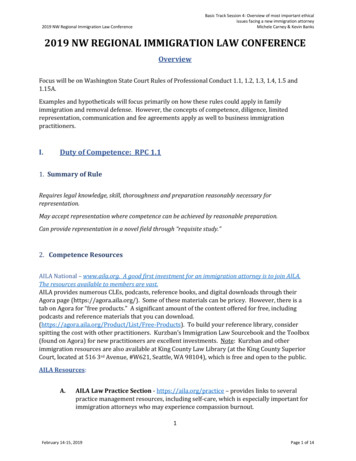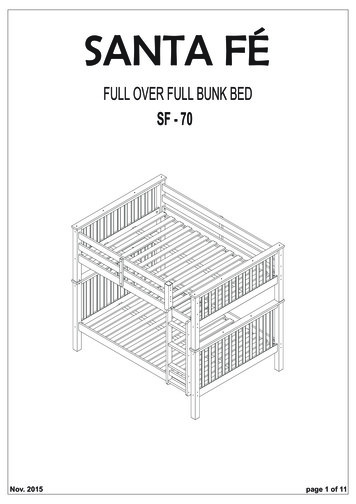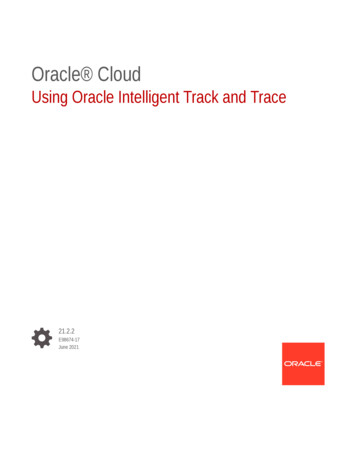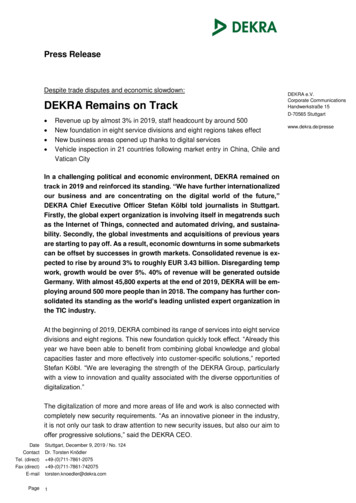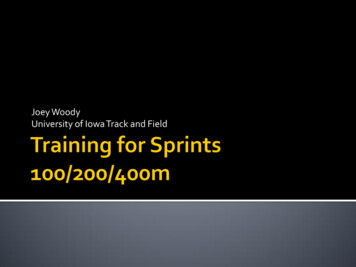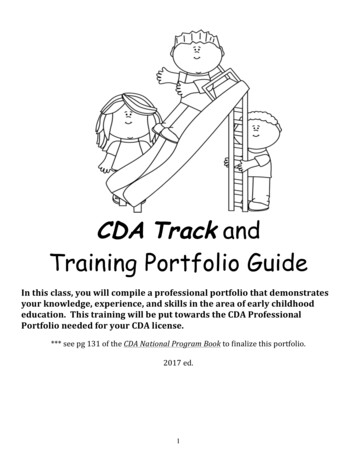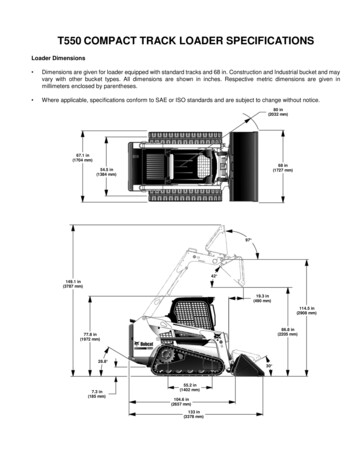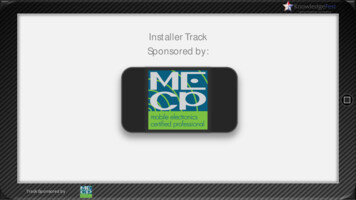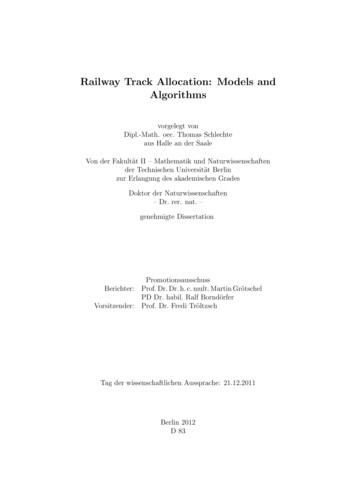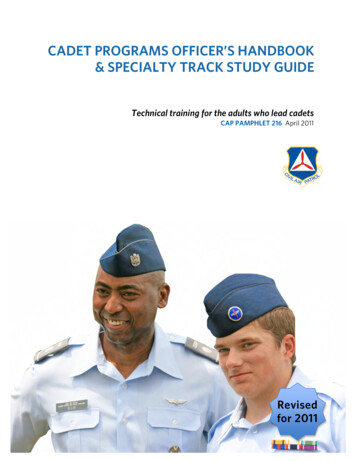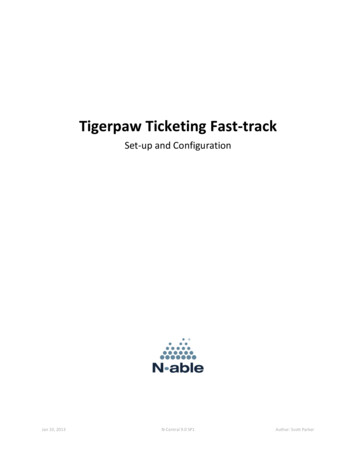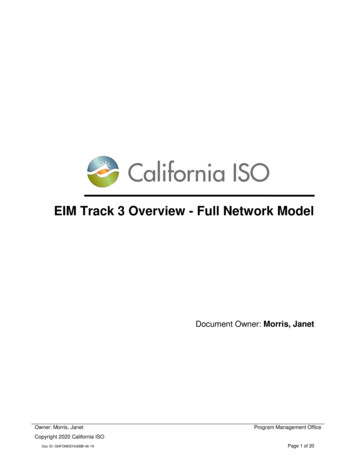
Transcription
EIM Track 3 Overview - Full Network ModelDocument Owner: Morris, JanetOwner: Morris, JanetProgram Management OfficeCopyright 2020 California ISODoc ID: GNFDMDEHU6BB-46-19Page 1 of 20
TechnologyEIM Track 3 Overview – Full Network ModelTemplateVersion:DocumentVersion:Date Created:1.01.65/19/2017REVISION HISTORYVERSION NO.DATEREVISED BYDESCRIPTION5/19/2017Joanne AlaiInitial document created5/19/2017Susan LennonWernerUpdated template5/22/2017Nancy StrouseUpdated template per instructions fromJoanne Alai1.19/28/2017Nancy StrouseUpdated table in Section 6 of template1.25/2/2019Cari ChenkinUpdated formatting, grammar, andpunctuation1.35/15/2019Ayman FattahUpdated 2021 implementation timeline1.406/21/2019Jie TongUpdated GRDT/IRDT Sections(Must matchheader)1.0Ayman Fattah1.56/16/2020Michael StewartUpdated Track 3 Key Deliverables for LoadForecast Development1.68/27/2020Ankit Mishra;Rachel Lucas;Joanne Alai;Nancy StrouseUpdated per input from Ankit and projectmanager. Updated copyright date.Owner: Morris, JanetProgram Management OfficeCopyright 2020 California ISODoc ID: GNFDMDEHU6BB-46-19Page 2 of 20
TechnologyEIM Track 3 Overview – Full Network ModelTemplateVersion:DocumentVersion:Date Created:1.01.65/19/2017TABLE OF CONTENTS1Purpose . 42Acronyms . 43Track 3 Overview . 44Track 3 Timeline . 55What to expect when integrating with the ISO Network Model . 76Cross Team Communication .107Track 3 Key Deliverables .108Track 3 Deliverable Examples.159Things to consider.17Owner: Morris, JanetProgram Management OfficeCopyright 2020 California ISODoc ID: GNFDMDEHU6BB-46-19Page 3 of 20
TechnologyEIM Track 3 Overview – Full Network ModelTemplateVersion:DocumentVersion:Date Created:1.01.65/19/20171 PurposeThe purpose of this document is to provide an entity who is joining the Energy Imbalance Market(EIM) with a summary and timing of key deliverables needed when integrating with the CaliforniaISO full network model (FNM).2 AcronymsBelow is a list of acronyms used in this document. Additional acronyms and term definitions arein the Definitions and Acronyms VARMWSCADASESLATNAVERExpansionBalancing AuthorityBulk Electric SystemBusiness Practice ManualCalifornia Independent Systems OperatorCommon Information ModelEnergy Imbalance MarketEnergy Management SystemFull Network ModelGenerator Resource Data TemplateInter-control Center Communications ProtocolIndependent Systems OperatorInformation TechnologyMega Volt Ampere ReactiveMegawattSupervisory Control and Data AcquisitionState EstimatorService Level AgreementTransmission Network ApplicationsVariable Energy Resource3 Track 3 OverviewThe ISO models transmission and generation assets in several systems; specifically, the NetworkModel in the ISO EMS and the Master File.The EMS is used to monitor the real-time status of the BES and to provide the real-time estimatedpower system solution necessary to determine the initial condition for real-time marketapplications. The same network model is also used by the TNA in the Market.As part of the EIM implementation, the ISO and EIM entity will integrate the EIM entity’s EMSmodel into the ISO EMS model. When these changes are implemented, the ISO will receive realtime data using an ICCP data link from the EIM entity. In Production, the EIM entity will follow theISO’s process to ensure that incremental updates to the EIM entity’s Network Model aresynchronized between the EIM entity and the ISO EMS systems. The ISO has transitioned to amonthly network model update process. Network model submission cutoff dates are posted inOwner: Morris, JanetProgram Management OfficeCopyright 2020 California ISODoc ID: GNFDMDEHU6BB-46-19Page 4 of 20
TechnologyEIM Track 3 Overview – Full Network ModelTemplateVersion:DocumentVersion:Date /Pages/NetworkandResourceModeling/Default.aspx). See the ISOBusiness Practice Manual for Managing Full Network Model for details on the production process.The EIM entity will work with its EMS vendor to export the EIM entity’s Network Model to the ISO.This includes exchange of supplemental data including but not limited to displays, data points,limits, and possible contingencies. This document details all the deliverables in a later section.The EIM entity will work with the ISO to integrate this data into the ISO’s Full Network Model. TheEIM entity and the ISO will establish an inter-control center communications protocol (ICCP) tobe used for transferring real-time data from the EIM entity to the ISO. The EIM entity will workwith its EMS vendor to upgrade baseline displays needed for communicating dispatch instructionsto generators, EIM entity transmission operations, and the ISO. The EIM entity will developinternal tools within its EMS to be used for communicating dispatch instructions to generators,EIM entity transmission operations, and the ISO.The Master File specifies many of the properties of the EIM entity’s generation and intertieresources for the purposes of scheduling, bidding and settlement. The EIM entity willcommunicate these properties to the ISO via the Generator Resource Data Template (GRDT)and the EIM interchange definition template. The generator properties specified in the Master File,such as minimum and maximum operating points, startup times and ramp rates, have a significantimpact on the way units are dispatched. These parameters should, as much as possible, alignwith the Network Model and meter data (Track 5). In Production, the EIM entity will follow theISO’s process to ensure incremental updates to the EIM entity GRDTs are incorporated in theISO Master File. Master File modifications have a Service Level Agreement (SLA) of ten businessdays and most modifications can be made until two weeks prior to the EIM productionimplementation.This document does not supersede the Full Network Model Business Practice Manual posted onthe ISO public site. Link to Business Practice Manual for Managing Full Network Model.4 Track 3 TimelineThe most critical milestone for Track 3 is Milestone 3, successful EIM entity Connectivity Testingin Map Stage. This is the point when the full network model, the market model, and the MasterFile are all available and validated in the Map Stage environment, allowing joint integration testingto begin between the ISO and the EIM entity. This is a critical milestone as any delays will impactthe downstream testing phases, including Day in the Life testing, Market Simulation, and ParallelOperations. Interim milestones are set to ensure Milestone 3 is met.Owner: Morris, JanetProgram Management OfficeCopyright 2020 California ISODoc ID: GNFDMDEHU6BB-46-19Page 5 of 20
TechnologyEIM Track 3 Overview – Full Network ModelOwner: Morris, JanetTemplateVersion:DocumentVersion:Date Created:1.01.65/19/2017Program Management OfficeCopyright 2020 California ISODoc ID: GNFDMDEHU6BB-46-19Page 6 of 20
TechnologyEIM Track 3 Overview – Full Network ModelTemplateVersion:DocumentVersion:Date Created:1.309/28/20175 What to expect when integrating with the ISO NetworkModelIntegrating a new EIM entity resource into the ISO FNM takes time, anywhere from eight to tenmonths, depending on the complexity of the EIM entity’s resource configuration, the CommonInformation Model (CIM) maturity of the EIM entity’s model, and resource availability. Below is asummary of how the process works.1. Initial FNM development and validationDeliverable: EIM entity model conforms to the CIM schema and data attributesPrerequisite: EIM entity and, if applicable, its EMS vendor, must understand the CIM 15 orCIM 10 format requirements and the ISO FNM Requirements. It is the responsibility of theEIM entity to understand the CIM format requirements. However, the ISO FNM Requirementsare provided to all entities and are located on the Accellion shared site/RIMS.Process:The EIM entity provides an export of their network model in the standard CIM 15 or CIM 10format. The requirements that the export must meet are detailed in the EIM CIM ModelRequirements document. If a new tool is required to create that extract, the EIM entity isresponsible for creating it. The ISO modeling team completes an initial validation to ensure that the format iscorrect and basic requirements are followed before attempting to import it into the ISOtest system. The validation is performed with standalone software packagesspecializing in CIMXML models. The ISO will provide written feedback via e-mail. Errors may be export errors, requiringmodifications to the export, or data errors. The EIM entity team will correct the errors and re-submit for review. This could take several iterations depending on the EIM entity’s and their vendor’slevel of familiarity with the CIM 15 format and the ISO requirements.2. Prepare SCADA data file aligning with the CIM Model.Deliverable: SCADA data from the EIM entity that aligns with the validated network model.Prerequisite: The network model has been validated and is frozen.Process: The ISO reviews the SCADA data provided by the EIM entity to validate that theSCADA data conforms to the stated requirements. The measurement associated with thenetwork model should be provided as a SCADA point. If any issues are found, they arecommunicated back to the EIM entity to be resolved.3. Import the EIM entity model into the ISO sandbox environment.Owner: Morris, JanetProgram Management OfficeCopyright 2020 California ISODoc ID: GNFDMDEHU6BB-46-19Page 7 of 20
TechnologyEIM Track 3 Overview – Full Network ModelTemplateVersion:DocumentVersion:Date Created:1.01.65/19/2017Deliverable: The EIM entity model is successfully imported into the ISO test environmentwithout errors and therefore approved by the ISO network model team. This is due in themonth T-15.Prerequisite: The CIM model has been validated and the ISO modeling team believes it isready for the first import into their model and includes individual unit resource ids andaggregation information. The measurement data in the network model must align with the EIMentity’s SCADA data associated with the model.Process: The ISO modeling team attempts to import the EIM entity model into their testenvironment. This process requires processing the model through modeling tools associatedwith the ISO’s EMS and Market systems. This process usually uncovers additional modelrelated issues and the model is being conformed to stricter validation requirements. When errors are identified, the ISO modeling team will provide the EIM entity modelingteam with a list of errors and, if known, some insights into what may be causing theproblem. The EIM entity team will correct the errors and re-submit for review. This could take several iterations. Once the model is processed through the ISO’s modeling tools, the model is consideredto be ready for downstream application and processes. This is also the model which willbe used during the Market Simulation efforts.4. Track Milestone: ISO approves EIM Entity FNM for Market Simulation (T-15, Januaryof the year before go-live year).At this point, the Market Simulation model is considered frozen by the ISO as the ISOdeployment to MAP Stage begins and changes will likely require re-work on the ISO side.While situations may arise where changes are requested in order to ensure the best MarketSimulation testing for the EIM entity, at this point in the process, any requests for changes tothe FNM for Market Simulation must be discussed between both the ISO and the EIM Entityto determine if the change is reasonable and feasible. This is due to the high potential forrework that may be required by the ISO. The ISO is committed to ensuring a robust and validMarket Simulation.5. Create GRDT.Deliverable: The EIM Entity populates the GRDT with the required EIM required data. Theresources definitions in the GRDT match the definitions in the Network Model (i.e., theaggregations and names are the same).Prerequisite: The ISO must approve the FNM for Market Simulation before the GRDT canbe completed. However, work on gathering the resource parameters for the GRDT shouldbegin well before the ISO approval of the Network Model.Process: Completion of the GRDT is an iterative process. Complete the GRDT computer-based training.Owner: Morris, JanetProgram Management OfficeCopyright 2020 California ISODoc ID: GNFDMDEHU6BB-46-19Page 8 of 20
TechnologyEIM Track 3 Overview – Full Network ModelTemplateVersion:DocumentVersion:Date Created:1.01.65/19/2017 EIM entity creates a draft GRDT for Participating Resources, coordinating with theNetwork Model development, and reviews and iterates with the ISO. EIM entity adds NPRs to the GRDT, coordinating with the Network Model development,and reviews and iterates with the ISO.The GRDT Template: Available on the Western EIM site.6. The ISO will integrate the EIM entity’s model for Market SimulationSolve power flow using the EIM entity’s model and the rest of the Western InterconnectionModel and integrate with the market application,
19.05.2017 · EIM Track 3 Overview – Full Network Model Date Created: 5/19/2017 Deliverable: The EIM entity model is successfully imported into the ISO test environment without errors and therefore approved by the ISO network model team. This is due in the month T-15. Prerequisite: The CIM model has been validated and the ISO modeling team believes it is
